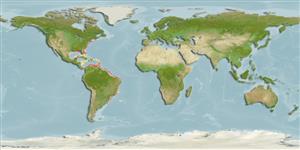Holocephali (chimaeras) >
Chimaeriformes (Chimaeras) >
Rhinochimaeridae (Longnose chimaeras)
Etymology: Neoharriotta: neo-, from neos (Gr.), new, i.e., a new genus related to Harriotta (See ETYFish); carri: in honor of James K. Carr (1914‒1980), former Under Secretary, U. S. Department of Interior, for “his great personal interest and counsel in the [Bureau of Commercial Fisheries’] exploratory fishing programs” (See ETYFish).
Eponymy: James K Carr (1914–1980) was Under Secretary at the US Department of the Interior (1961–1964). [...] (Ref. 128868), visit book page.
Environment: milieu / climate zone / depth range / distribution range
Ecology
Marine; bathydemersal; depth range 340 - 600 m (Ref. 26786). Deep-water
Western Central Atlantic: Caribbean Sea off the coasts of Colombia and Venezuela.
Size / Weight / Age
Maturity: Lm ? range ? - ? cm
Max length : 59.6 cm TL male/unsexed; (Ref. 30438); 74.5 cm TL (female)
Confined to upper and mid-slope depths (Ref. 30438). Oviparous (Ref. 205). Eggs are encased in horny shells (Ref. 205).
Life cycle and mating behavior
Maturity | Reproduction | Spawning | Eggs | Fecundity | Larvae
Didier, D.A. and M. Stehmann, 1996. Neoharriotta pumila, a new species of longnose chimaera from the northwestern Indian Ocean (Pisces, Holocephali, Rhinochimaeridae). Copeia 1996(4):955-965. (Ref. 26786)
IUCN Red List Status (Ref. 130435: Version 2024-1)
Threat to humans
Harmless
Human uses
Tools
Special reports
Download XML
Internet sources
Estimates based on models
Preferred temperature (Ref.
123201): 8.8 - 17, mean 10.6 °C (based on 31 cells).
Phylogenetic diversity index (Ref.
82804): PD
50 = 0.6289 [Uniqueness, from 0.5 = low to 2.0 = high].
Bayesian length-weight: a=0.00195 (0.00085 - 0.00449), b=3.14 (2.94 - 3.34), in cm total length, based on LWR estimates for this (Sub)family-body shape (Ref.
93245).
Trophic level (Ref.
69278): 3.7 ±0.5 se; based on size and trophs of closest relatives
Resilience (Ref.
120179): Low, minimum population doubling time 4.5 - 14 years (Assuming Fec <100).
Fishing Vulnerability (Ref.
59153): Moderate to high vulnerability (50 of 100).
